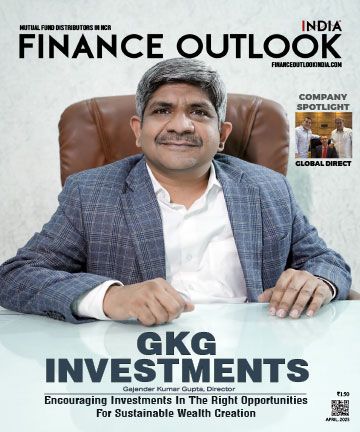Nelson D’Souza is the Chief Financial Officer at Ecofy, where he leads financial strategy, fundraising, and investor relations to drive sustainable growth. With over two decades of experience across large corporations and startups, Nelson blends structure with agility. He has served as CFO for multiple startups from seed to Series C stages, successfully leading multi-million-dollar equity and debt fundraises, including venture debt and promoter funding. Nelson also specializes in financial planning, cost optimization, product pricing, and investor relations. His sectoral experience spans food-tech, digital commerce, lending, logistics, media, and consumer businesses. A Chartered Accountant from ICAI and a commerce graduate from Mumbai University, Nelson is deeply passionate about entrepreneurship, innovation, and inclusive growth.
In an exclusive interaction with Finance Outlook India, Nelson D’Souza, Chief Financial Officer shedd light how access to green finance & financial innovation is fueling India’s clean energy transition:
How has demand for green financing changed over the past few years, and what role do NBFCs play in driving this transition?
The green finance landscape in India has experienced a seismic shift over recent years. It has evolved from a niche segment to a cornerstone of our economic future. What was once considered an alternative financing model has now emerged as a mainstream necessity with projections indicating a fivefold growth to ₹31 lakh crore by the year 2030. This exponential trajectory is not merely a reflection of regulatory compliance but represents a fundamental shift in market consciousness toward sustainable growth imperatives.
NBFCs, particularly specialized, green-focused ones, have emerged as critical catalysts in accelerating this transition by addressing the gaps that traditional banking frameworks have been slow to fill. They are uniquely positioned to deploy capital with agility and precision, particularly in the underserved retail and SME segments that form the backbone of India's economic engine. By focusing exclusively on green assets—from electric vehicles to rooftop solar installations—these NBFCs are not simply financing products but financing India's commitment to install 500 GW of renewable energy by 2030 and clock net-zero emissions by 2070. Their targeted approach to small-ticket, high-impact green loans is democratizing access to sustainable technologies and expediting the decarbonization of our economy from the ground up.
What financial models or innovations are being used to make green loans more accessible and affordable?
The democratization of green finance demands innovative financial architectures that cut across conventional lending paradigms. A digital-first approach is being pioneered that fundamentally reimagines the borrowing experience for India's underserved retail segment. This primarily involves reconstructing the entire financing ecosystem to eliminate friction points that have historically impeded green adoption.
Financial innovation begins with strategic OEM partnerships that enable flexible EMI structures and integrated maintenance contracts to create a value proposition that extends well beyond competitive interest rates. For rooftop solar installations, accelerated disbursal protocols have been developed that collapse traditional timelines, allowing households and SMEs to realize electricity bill reductions of up to 50% almost immediately. This speed-to-benefit model proves critical in overcoming initial resistance to green investments.
Looking forward, a number of blended finance mechanisms are being explored that combine concessional climate funds with commercial capital to further reduce borrowing costs. This approach helps in ensuring sustainable technologies remain accessible while simultaneously aligning financial incentives with climate impacts—indicating a crucial evolution in how we value and price green assets. By embedding ecosystem support directly into financial products, what might otherwise be viewed as premium financing is being transformed into an economically compelling proposition with evident returns.
How do you assess the creditworthiness of individuals and businesses investing in green assets like EVs and solar?
The approach to credit assessment represents a paradigm shift that incorporates both traditional financial metrics and forward-looking sustainability indicators. While conventional creditworthiness models remain foundational, proprietary frameworks are being developed that quantify the economic advantage that green assets generate to effectively recognize how reduced operating costs from EVs or solar installations enhance repayment capacity over time.
For EV financing, total cost of ownership is analyzed across the asset lifecycle, including maintenance savings, fuel cost differentials, and potential revenue enhancement for commercial vehicles. Partnerships with leading OEMs provide critical data on asset performance and depreciation patterns, enabling more accurate risk pricing. Similarly, for rooftop solar investments, electricity cost savings are incorporated as a positive cash flow factor—essentially treating sustainability as an economic strength rather than merely an environmental preference.
For SMEs, both balance sheet fundamentals and the strategic advantage that green transitions confer in their respective sectors are evaluated, particularly as supply chains increasingly prioritize partners with lower carbon footprints. This multidimensional assessment allows for the extension of financing to segments that might appear marginal under traditional scoring systems but represent strong prospects when their green investments are properly valued. Portfolio performance across 21+ states validates this approach to successfully demonstrate that financing the green transition can be both environmentally impactful and financially sound.
"Green finance is no longer a niche—it's the foundation of India's economic future. Financing climate solutions is now indistinguishable from financing growth
With the growing push for net-zero commitments, how can financial institutions encourage SMEs to adopt greener solutions?
Financial institutions must evolve from passive capital providers to active partners in the SME green transition journey. The imperative for net-zero alignment is clear, but for most SMEs, the path remains obscured by perceived complexity, upfront costs, and competing priorities. Effective engagement requires a three-dimensional approach: simplifying access, demonstrating economic value, and creating ecosystem support.
First, green finance must be demystified through purpose-built products that address sector-specific sustainability challenges. For manufacturing SMEs, this might mean equipment modernization financing that improves energy efficiency; for service businesses, it could be green building retrofits that reduce operational costs. Second, financial institutions must articulate the business case in concrete terms to quantify how green investments translate to enhanced competitiveness, particularly as larger corporations increasingly scrutinize their supply chain emissions. Finally, supportive ecosystems must be constructed around these enterprises, connecting them with technology providers, implementation experts, and certification bodies.
Bundling warranties, insurance, and technical support with financing creates a comprehensive solution that mitigates adoption barriers. By reducing the fragmentation that SMEs typically encounter when pursuing sustainability initiatives, financial institutions can accelerate the transition while simultaneously opening new markets. This process naturally entails reimagining how financial institutions can serve as strategic enablers of the net-zero economy.
What are the unique financial risks associated with green lending, and how do NBFCs mitigate them?
Green lending encompasses distinctive risk profiles that demand sophisticated mitigation strategies beyond conventional credit frameworks. The foremost among these is technological risk, particularly for emerging green solutions where performance data may be limited and obsolescence concerns heightened. Second is policy risk, where regulatory landscapes evolve rapidly and incentive structures shift accordingly. Third is market adoption risk, as consumer behavior patterns remain in flux as green alternatives move from early adopters to mainstream markets.
The approach to managing these unique dimensions begins with technology validation through partnerships with reputable OEMs and manufacturers who provide performance guarantees and maintenance support. This ecosystem-driven model distributes risk across the value chain while ensuring end-users receive comprehensive support throughout the asset lifecycle. For policy risk, active engagement with regulatory developments is maintained, and flexible product structures are designed to adapt to evolving frameworks and formulate policy-resilient portfolios.
Perhaps most importantly, specialized underwriting capabilities have been developed that extend beyond traditional financial analysis to incorporate sustainability metrics and forward-looking impact assessments. This enables more accurate risk pricing for green assets while accounting for their unique value proposition. Portfolio diversification across multiple green sectors—from electric mobility to distributed solar—further strengthens resilience against segment-specific fluctuations. As a specialized green NBFC, this focused expertise represents a competitive advantage in identifying opportunities that others might inaccurately categorize as risks.
How do partnerships with financial institutions, investors, and policymakers help accelerate the green transition?
The scale and complexity of India's sustainability transition demands orchestrated collaboration across the financial ecosystem. No single institution, regardless of its commitment or capability, can independently address the ₹10.1 trillion financing requirement for our net-zero journey. Strategic partnerships are viewed not merely as capital aggregation mechanisms but as force multipliers that enhance impact across multiple dimensions.
Perhaps most transformative of all are industry partnerships with manufacturers, technology providers, and implementation specialists, which have enabled the development of end-to-end solutions rather than isolated financing products. This ecosystem approach ensures that capital deployment is synchronized with technology availability, installation capacity, and maintenance support, thereby eliminating the fragmentation that often thwarts green adoption. The resulting network effect accelerates both the velocity and volume of capital flowing into sustainable investments to create momentum that surpasses what any individual institution could achieve independently.
What is your outlook on the future of green finance in India, and how do you see it evolving in the next few years?
India stands at the threshold of the world's most consequential green transition that must balance the aspirations of 1.3 billion citizens with ecological imperatives. Green finance isn't merely a subset of our financial architecture; it is rapidly becoming the only viable framework for sustainable economic advancement. The projected fivefold growth to ₹31 lakh crore by 2030 understates the transformative potential ahead, as policy frameworks mature and market forces increasingly favor sustainable investments.
In the coming years, three fundamental shifts are anticipated in India's green finance landscape. First, a deepening integration of sustainability metrics into mainstream financial decision-making, moving beyond designated "green products" toward comprehensive ESG incorporation across all financing activities. Second, a democratization of access as digital platforms and specialized NBFCs extend green financing opportunities to previously underserved segments, particularly in semi-urban and rural markets. Third, a sophistication of instruments beyond traditional debt, including green bonds, sustainability-linked loans, and potentially carbon-linked financial products that monetize emissions reductions directly.
Government initiatives like the National Green Hydrogen Mission and the Production-Linked Incentive schemes will continue creating structural enablers, but the true catalyst will be market recognition of sustainability as an economic imperative rather than merely an environmental preference. The most exciting opportunities will emerge at the critical intersection where purpose meets profitability - and where financing climate solutions becomes indistinguishable from financing India's economic future.


